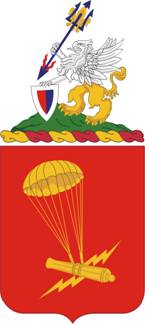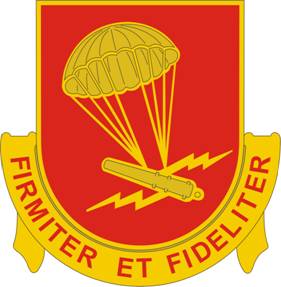377th Field Artillery Regiment, US Army
377TH FIELD ARTILLERY REGIMENT, US ARMY
| (Coat of Arms) |
(Distinctive Unit Insignia) |
Official blazon
Shield: Gules, an open parachute attached to a cannon flotant across a flash Or.
Crest: On a wreath of the colors Or and Gules, on a mound Vert a griffin, the lower (lion) part of the first and the upper (eagle) part including wings Argent, holding in dexter talons a trident bendwise sinister Azure, the tines impaling a fleur-de-lis of the first, the shaft terminating in an arrowhead of the fifth enflamed Tenné and the sinister talons resting on the top of a shield per pale Gules and of the firth within a border of the fourth.
Motto: FIRMITER ET FIDELITER (Steadfastly and Faithfully).
Distinctive Unit Insignia. Description: A Gold color metal and enamel device 1 1/8 inches (2.86 cm) in height overall consisting of a shield blazoned: Gules, an open parachute attached to a cannon flotant across a flash Or. Attached below and to the sides of the shield a Gold scroll inscribed “FIRMITER ET FIDELITER” in Red letters.
Origin/meaning
The scarlet of the shield is for Field Artillery. The floating parachute with the cannon attached is symbolic of airborne functions of the organization. Crest: The griffin is a fabulous animal half eagle and half lion. The eagle alludes to the organization having served with the 101st Airborne (Screaming Eagle) Division in World War II and the lion to England, where it underwent training and from whence it “took off” for its air assault drops on Normandy and the Netherlands. The trident refers to “Operation Neptune” which launched the invasion of Normandy symbolized by the fleur-de-lis, an emblem of France, impaled on the tines, and alludes to the Normandy air drop. The arrowhead and orange flames (orange is the Netherlands’ national color) refers to the air drop on the Netherlands. The red and blue shield, suggested by the coat of arms of Bastogne, refers to the gallant defense of Bastogne, and has been “surrounded by” a border in allusion to the town being surrounded by the enemy and is white to simulate snow, the action having taken place during winter. The green mound refers to the Rhineland campaign and Southern Germany.
The coat of arms was originally approved for the 377th Parachute Field Artillery Battalion on 14 November 1942. It was redesignated for the 515th Airborne Field Artillery Battalion on 26 September 1951. It was redesignated for the 377th Airborne Field Artillery Battalion on 31 July 1956. On 26 February 1958, the insignia was redesignated for the 377th Artillery Regiment. It was amended to add a crest to the coat of arms on 16 November 1964. The insignia was redesignated for the 377th Field Artillery Regiment on 25 January 1972. The distinctive unit insignia was originally approved for the 377th Parachute Field Artillery Battalion on 14 November 1942. It was redesignated for the 515th Airborne Field Artillery Battalion on 26 September 1951. It was redesignated for the 377th Airborne Field Artillery Battalion on 31 July 1956. On 26 February 1958, the insignia was redesignated for the 377th Artillery Regiment. The insignia was redesignated for the 377th Field Artillery Regiment on 25 January 1972.
Literature: Images from Wikimedia Commons. Information from The Institute of Heraldry, US Army.

